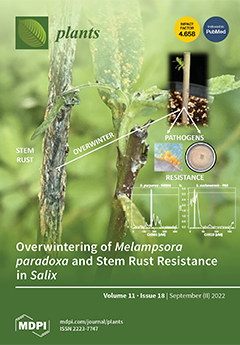Periods of soil water stress have been recurrent in the Cerrado region and have become a growing concern for Brazilian tropical pasture areas. Thus, the search for forage grasses more tolerant to water stress has intensified recently in order to promote more sustainable livestock. In a greenhouse experiment, the degree of water stress tolerance of nine tropical forage grass cultivars was studied under different soil water regimes. The investigation followed a 9 × 3 factorial design in four randomized blocks. Nine cultivars from five species of perennial forage grasses were tested:
Urochloa brizantha (‘BRS Piatã’, ‘Marandu’, and ‘Xaraés’),
Panicum maximum (‘Aruana’, ‘Mombaça’, and ‘Tanzânia’),
Pennisetum glaucum (‘ADR 300’),
Urochloa ruziziensis (‘Comum’), and
Paspalum atratum (‘Pojuca’). These cultivars were grown in pots under three soil water regimes (high soil water regime—HSW (non-stressful condition), middle soil water regime—MSW (moderate water stress), and low soil water regime—LSW (severe water stress)). Plants were exposed to soil water stress for 25 days during the tillering and stalk elongation phases. Twelve tolerance indices, including tolerance index (TOL), mean production (MP), yield stability index (YSI), drought resistance index (DI), stress tolerance index (STI), geometric mean production (GMP), yield index (YI), modified stress tolerance (k
1STI and k
2STI), stress susceptibility percentage index (SSPI), abiotic tolerance index (ATI), and harmonic mean (HM), were calculated based on shoot biomass production under non-stressful (Y
P) and stressful (Y
S) conditions. Soil water stress decreased leaf area, plant height, tillering capacity, root volume, and shoot and root dry matter production in most cultivars, with varying degrees of reduction among tropical forage grasses. Based on shoot biomass production under controlled greenhouse conditions, the most water-stress-tolerant cultivars were
P. maximum cv. Mombaça and cv. Tanzânia under the MSW regime and
P. maximum cv. Aruana and cv. Mombaça under the LSW regime.
P. maximum cv. Mombaça has greater adaptability and stability of shoot biomass production when grown under greenhouse conditions and subjected to soil water stress. Therefore, this forage grass should be tested under field conditions to confirm its forage production potential for cultivation in tropical regions with the occurrence of water stress. The MP, DI, STI, GMP, YI, k
2STI, and HM tolerance indices were the most suitable for identifying forage grass cultivars with greater water stress tolerance and a high potential for shoot biomass production under LSW regime.
Full article






